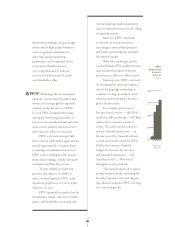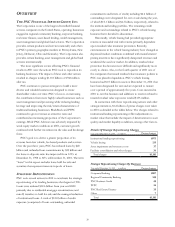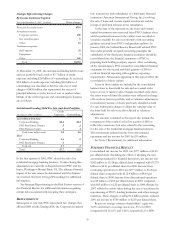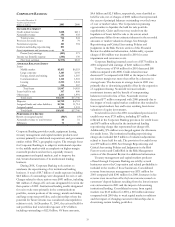PNC Bank 2001 Annual Report Download - page 32
Download and view the complete annual report
Please find page 32 of the 2001 PNC Bank annual report below. You can navigate through the pages in the report by either clicking on the pages listed below, or by using the keyword search tool below to find specific information within the annual report.30
The residential mortgage banking business is reflected in
discontinued operations throughout the Corporation’s
consolidated financial statements. Accordingly, the earnings
and net assets of the residential mortgage banking business
are shown separately on one line in the income statement and
balance sheet, respectively, for all periods presented. The
remainder of the presentation in this Financial Review
reflects continuing operations, unless otherwise noted.
Taxable-equivalent net interest income of $2.278 billion
for 2001 increased 4% compared with 2000. The increase was
primarily due to the impact of transaction deposit growth and
a lower rate environment that was partially offset by the
impact of continued downsizing of the loan portfolio. The
net interest margin widened 20 basis points to 3.84% for
2001 compared with 3.64% for 2000. The increase was
primarily due to the impact of the lower rate environment,
the benefit of growth in transaction deposits and the
downsizing of higher-cost, less valuable retail certificates and
wholesale deposits.
The provision for credit losses was $903 million for 2001,
which included expense of $714 million associated with the
institutional lending repositioning initiatives described above.
The provision was $136 million in 2000.
Noninterest income was $2.543 billion for 2001
compared with $2.891 billion in 2000. Noninterest income in
2001 included charges of $259 million for valuation
adjustments on loans held for sale related to the institutional
lending repositioning and $17 million of charges for asset
impairments associated with other strategic initiatives. A $111
million increase in net securities gains and growth in asset
management, fund servicing, consumer services and other
revenue was more than offset by net losses of $179 million
resulting from lower valuations of equity management
investments as well as reduced brokerage and corporate
services revenue as a result of lower capital markets activity.
Noninterest expense was $3.338 billion for 2001
compared with $3.071 billion for 2000. Excluding charges in
2001 of $135 million related to PNC’s vehicle leasing
business and $56 million of integration and severance costs
related to downsizing and other strategic initiatives,
noninterest expense increased 2% compared with 2000.
Total assets were $69.6 billion at December 31, 2001
compared with $69.8 billion at December 31, 2000. At
December 31, 2001, loans were $38 billion and loans held for
sale were $4.2 billion, including $2.6 billion of institutional
loans held for sale. At December 31, 2000, loans were $50.6
billion and loans held for sale were $1.7 billion, consisting
primarily of student loans. Average interest-earning assets
were $59.3 billion for 2001 compared with $59.9 billion for
2000. A decline in average loans and average loans held for
sale was largely offset by an increase in average securities
available for sale.
Shareholders’ equity totaled $5.8 billion at December 31,
2001 compared with $6.7 billion at December 31, 2000. The
payment of dividends, the impact of share buybacks, the
retirement of preferred stock and lower earnings in 2001
accounted for the decline. During 2001, PNC repurchased
9.5 million shares of common stock and purchased and
retired preferred stock for $301 million. The regulatory
capital ratios were 6.8% for leverage, 7.8% for tier I risk-
based and 11.8% for total risk-based capital at December 31,
2001 compared with 8.0% for leverage, 8.6% for tier I risk-
based and 12.6% for total risk-based capital at December 31,
2000.
Nonperforming assets were $391 million at December 31,
2001 compared with $372 million at December 31, 2000. The
ratio of nonperforming assets to total loans, loans held for
sale and foreclosed assets was .93% at December 31, 2001
compared with .71% at December 31, 2000.
The allowance for credit losses was $630 million and
represented 1.66% of total loans and 299% of nonaccrual
loans at December 31, 2001. The comparable amounts were
$675 million, 1.33% and 209%, respectively, at December 31,
2000. See Note 11 Allowance For Credit Losses, Critical
Accounting Policies and Judgments in the Risk Factors
section and Credit Risk in the Risk Management section of
this Financial Review.
2002 OPERATING ENVIRONMENT
Management expects 2002 will be another challenging year
with a weak economy and moderate capital markets recovery,
if any. The following challenges, and the Corporation’s
success in addressing them, will be among the factors that
influence PNC’s 2002 operating results and its ability to
redeploy capital, mitigate or avoid additional valuation
charges to earnings, and meet revenue and earnings targets
for 2002:
• Expeditious disposition of loans held for sale without
significant valuation losses;
• Maintaining stable asset quality in all loan portfolios;
• Successfully integrating the National Bank of Canada
(“NBOC”) asset-based lending acquisition and managing
the related serviced portfolio as described on page 35;
• Continuing to invest in and sustain revenue growth of
fee-based businesses such as asset management and
processing notwithstanding market volatility and intense
competition; and
• Continuing to improve the risk/return dynamics of
traditional banking businesses by building value-added
customer relationships, leveraging technology and
managing the revenue/expense relationship.
See the Risk Factors, Risk Management and Forward-
Looking Statements sections of this Financial Review for
additional information.
























